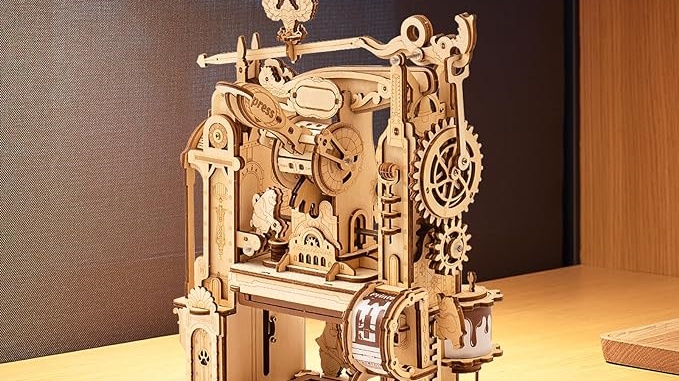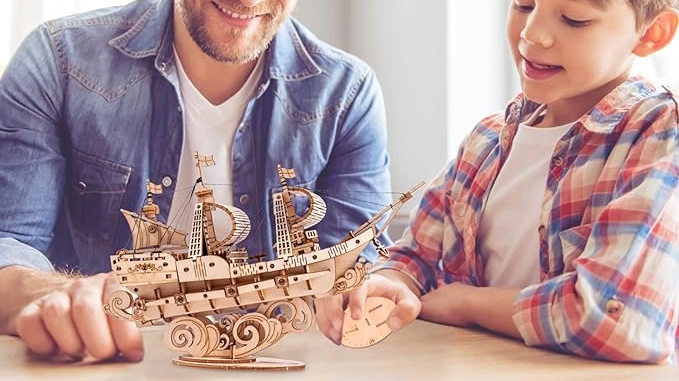
Wooden Puzzle Boxes vs. Paper One For Toddlers: An In-Depth Comparison
When choosing the right puzzle box(wooden puzzle boxes or paper one) for your toddler, it’s essential to consider the materials’ properties and how they align

Imagine a wooden jigsaw puzzle where each piece is more than a part of an image; it’s a chapter in a captivating story waiting to be told.
This guide invites you on a creative journey to transform any wooden puzzle into a narrative adventure, blending the joy of puzzle assembly with the thrill of storytelling.
Here, we’ll explore how to weave tales into puzzles, turning each session into an interactive story that unfolds with every piece placed.
By the end, you’ll have not just a completed puzzle but a rich narrative woven through it, offering a unique experience that delights, educates, and engages.
The foundation of a narrative puzzle is its story. Let’s delve deeper into crafting a tale that resonates and captivates.
Choosing the right theme is akin to choosing the destination for an adventure. For a younger audience, a theme revolving around a quest—such as a young hero embarking on a journey to discover lost worlds or a magical creature needing help to save its enchanted forest—can kindle imagination and curiosity.

Adults might appreciate a complex narrative, like a mystery that spans historical epochs, inviting them to unravel secrets piece by piece.
Consider incorporating themes that offer not just entertainment but also opportunities for learning, whether it’s about historical events, scientific discoveries, or cultural stories.
This step is where your narrative starts taking shape visually and structurally. Imagine dividing your story into segments, each represented by sections of the puzzle.
For a tale of exploration, the initial pieces might depict the early days of a journey, with maps and compasses, while the middle sections plunge into challenges faced along the way—stormy seas, mysterious terrains.
The final pieces could reveal the destination, be it a mythical city or a newfound land, with details that reward the solver’s perseverance. This method ensures a progressive unveiling of the story, engaging the solver’s curiosity and determination.
Your puzzle should not only challenge the intellect but also stir emotions. Begin with an introduction that sets the scene and introduces the characters and their motivations.
The buildup could involve overcoming obstacles or solving mysteries, gradually increasing in complexity and intrigue.
Climax with a pivotal moment that brings the story to its peak, such as a dramatic revelation or a final battle.
Conclude with a resolution that ties up the storylines, offering a sense of closure and achievement. This narrative arc ensures a satisfying journey, making the final assembly deeply rewarding.
Bringing your story to life visually is crucial in crafting an engaging narrative puzzle.
Each visual element should serve the story, from the overarching scenes down to the minutiae.
Begin with broad strokes—sketching out major scenes and characters—then zoom in to the details.
For example, if your story involves a quest for a hidden treasure, illustrate not just the adventurers and the treasure but also the cryptic clues and ancient artifacts they encounter.
Use visual cues to guide the solver through the story, such as distinct symbols or colors that highlight key plot points or suggest connections between pieces.

Colors and artistic styles are powerful storytelling tools. A story set in a lush, mysterious jungle could use vibrant greens and deep shadows to evoke a sense of wonder and danger.
A tale of a cold, distant planet might employ stark blues and silvers, creating a feeling of otherworldliness.
The style of illustration—be it detailed and realistic or stylized and abstract—should reflect the tone and theme of your story, enhancing the emotional and aesthetic appeal of the puzzle.
Visual storytelling in puzzles is not just about the image but also how the image interacts with the puzzle’s form.
Consider innovative piece shapes that echo elements of the story, such as a piece shaped like a key fitting into a lock-shaped piece for a mystery-themed puzzle.
These design choices add layers of discovery and interaction, making the puzzle-solving process a more integral part of the storytelling experience.
The transformation of your narrative and visual designs into a tangible puzzle is a meticulous process that marries art with craftsmanship.
Choosing the right materials is crucial for the look, feel, and durability of your puzzle.
Premium woods like birch or cherry offer a smooth, sturdy canvas for your story, while advanced printing techniques ensure that every hue and detail of your design is captured vividly.
The texture of the wood and the quality of the print can greatly enhance the tactile experience of puzzle assembly, making every piece a pleasure to handle and fit.
This stage is where your digital design becomes a physical reality. Begin with a high-resolution print of your artwork, carefully adhering it to the wood surface.
Precision cutting is crucial; laser cutting offers unmatched accuracy, allowing for intricate shapes and snug fits.
As you cut, consider the flow of the story across the puzzle pieces, ensuring that key elements are well distributed and contribute to the narrative journey.
Before declaring the puzzle complete, assemble it yourself to ensure every piece fits perfectly and the story unfolds as intended.

This test run is not just about quality control but also about experiencing the narrative firsthand.
It’s an opportunity to make final adjustments, ensuring that the story is coherent, the visuals are engaging, and the puzzle offers a satisfying challenge.
Creating a wooden jigsaw puzzle that tells a story is a journey of imagination, design, and craftsmanship. It transforms the puzzle from a mere pastime into an immersive narrative experience, where each piece not only fits into another but also contributes to a larger tale.
This guide has walked you through conceptualizing a theme, designing a storyboard, bringing the story to life visually, and crafting the final puzzle. The result is a work of art that offers not just the satisfaction of completion but also the joy of storytelling.
As you embark on creating your own story-driven puzzles, remember that each piece is a narrative waiting to be unveiled, offering endless possibilities to captivate, educate, and inspire.
How can I choose the right story for my audience?
When selecting a story for your puzzle, consider the interests, age range, and cultural background of your intended audience. For children, stories with clear moral lessons or adventurous themes are often engaging. For adults, you might choose more complex narratives, such as historical tales or intricate mysteries. Think about what themes resonate most with your audience and what kind of stories can spark curiosity and provide a rewarding puzzle-solving experience.
Can I create a puzzle with a non-linear storyline?
Absolutely! Non-linear storylines can add an intriguing layer of complexity to your puzzle. You can design the puzzle so that pieces can be assembled in multiple ways, each offering a different aspect of the story, or include hidden clues that only make sense when viewed from a certain perspective. This approach encourages solvers to think creatively and explore different narrative possibilities as they piece the puzzle together.
What if I’m not an artist? Can I still design a visually compelling story puzzle?
Yes, you don’t need to be a professional artist to create a visually compelling story puzzle. There are many resources available for beginners, including digital illustration tools that are user-friendly and tutorials that can help you develop your skills. Additionally, you could collaborate with an artist whose style matches the vision for your story, or use royalty-free images and software to create composite images that bring your narrative to life.
How do I ensure the puzzle pieces fit together well without losing the narrative thread?
Achieving a balance between a well-fitting puzzle and maintaining the narrative thread requires careful planning during the design phase. Ensure that the story flows logically across the puzzle, with each piece contributing to the overall narrative. Using software that specializes in puzzle design can help you visualize how the pieces fit together while keeping the story intact. Additionally, consider including visual or textual clues on the pieces that help solvers understand the story as they progress.
What materials should I avoid when printing and cutting my narrative puzzle?
When selecting materials for your puzzle, avoid woods that are too soft, as they may warp or break easily, and inks that fade quickly or smear upon handling. Opt for durable, high-quality woods like birch or maple and use archival-quality inks for printing to ensure the longevity and vibrancy of your puzzle. Additionally, steer clear of adhesives that might yellow or degrade over time, affecting the puzzle’s appearance and durability.


When choosing the right puzzle box(wooden puzzle boxes or paper one) for your toddler, it’s essential to consider the materials’ properties and how they align

Embark on a journey to unravel the nuanced distinctions between two beloved genres of puzzles: plain wooden puzzles and 3d wooden puzzles. In this comprehensive

Imagine your wooden jigsaw puzzle not just as a piece to be solved but as an interactive journey that engages all your senses. This guide

In the enchanting world of puzzle assembly, the choice of storage can be as personal and complex as the puzzles themselves. Wooden puzzle boxes whisper

Imagine a wooden jigsaw puzzle where each piece is more than a part of an image; it’s a chapter in a captivating story waiting to

When choosing the right puzzle box(wooden puzzle boxes or paper one) for your toddler, it’s essential to consider the materials’ properties and how they align

Embark on a journey to unravel the nuanced distinctions between two beloved genres of puzzles: plain wooden puzzles and 3d wooden puzzles. In this comprehensive

Imagine your wooden jigsaw puzzle not just as a piece to be solved but as an interactive journey that engages all your senses. This guide
Copyright © 2024 woodcraft3dpuzzles. All Rights Reserved.